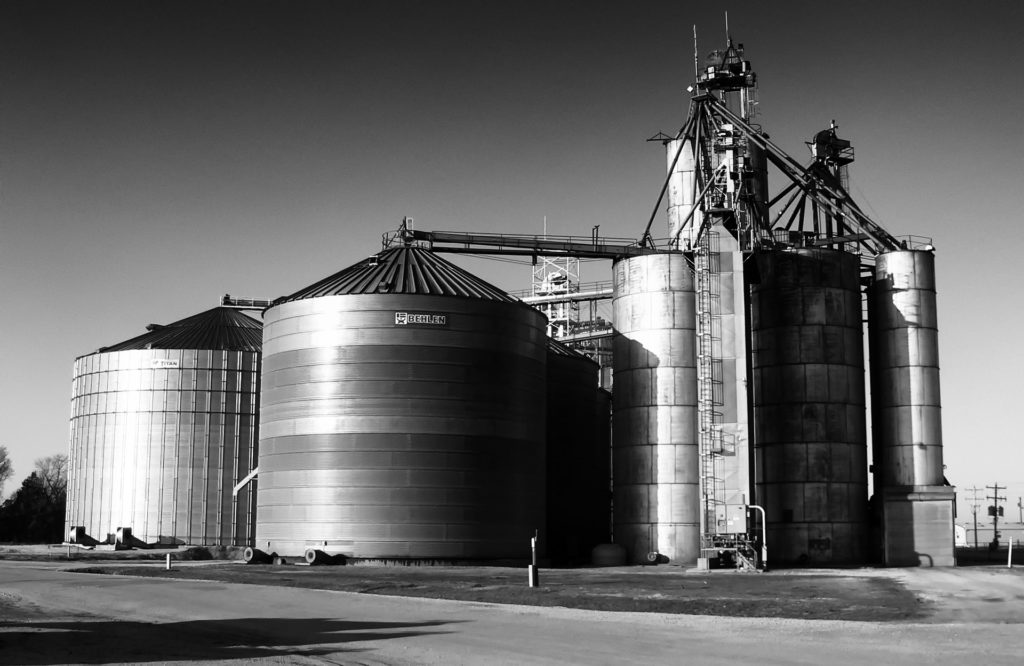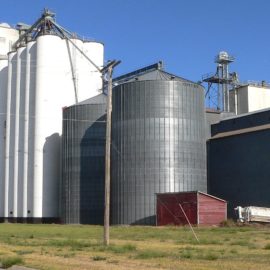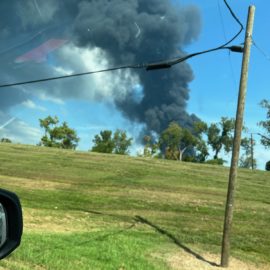
In Wallace the grain elevator stirs emotions both good and bad.. Jobs versus pollution and where you sit determines which you favor.
Bienville Jackson of Wallace fears his community is dying. When young people head off to college, many never come back. There are few places to work in the settlement of fewer than 800 people. So, in March of last year, when Greenfield Louisiana’s plans to build a $400 million grain elevator in Jackson’s neighborhood became public, Jackson was ecstatic. “We need this. Not for me, but for the younger kids,” said Jackson, who works for the St. John Parish sheriff’s office and at its courthouse. “To bring jobs, industry, stores.… It’s not growing over here.”
nola.com
Jobs are important but so is the health of the residents especially as they are buffeted by many industries all polluting and fouling the air.
Despite the promise of jobs, the proposed grain elevator has divided residents around Wallace, which is located on the parish’s rural west bank and counts among its few businesses a gas station and a McDonald’s. Though Jackson and some others see the huge planned facility as a boon, another segment of the community opposes the move, citing the negative effects of grain dust on human health and the chance that the elevator’s construction could disturb the graves of the enslaved people from whom many present-day residents descend. Residents sued in November 2021 to try to stop the project, citing those and other issues. The case is still wending its way through the courts. “These decisions are huge… (The lawsuit is) about protecting our history, our burial grounds and the culture of the area,” said Jo Banner, a founder of the group behind the lawsuit, the Descendants Project. Banner and her sister Joy Banner live one street over from the site. On the defenGreenfield still needs a permit from the Army Corps of Engineers to build the elevator; the lawsuit has also stymied construction. se is Greenfield, a subsidiary of international grain exporter Greenfield Holdings LLC. The company’s representatives say the elevator will bring hundreds of new jobs to the area and that its dust traps will capture errant particles. Claims that the company doesn’t care about the community are untrue, its representatives said. They cited company plans to help the west bank’s only public high school train students to be ready for employment with Greenfield after graduation, as well as plans to open a community foundation and a health clinic.
Many small towns are dying off as the young leave for jobs and the older die off. This is a nationwide problem not just here.
Wallace is just one of the towns that descendants of the former Whitney Plantation call home. Others are the towns of Vacherie, which lies just upriver, and Edgard, the parish seat, in the other direction. Area residents who back the elevator point to population declines spurred by the relative lack of jobs in the vicinity. Though census data show Wallace has seen a 13% uptick in its tiny population over the past decade, Vacherie, home today to 5,481 people, is down by 8% since 2010. Edgard has taken an even greater hit, losing a fifth of its population from 2010 to 2020. St. John’s overall population was at 42,477 in 2020, down 8% from 2010. Meanwhile, the average unemployment rate in Wallace from January to June of this year is 6.5%, well above the state average of 4%. The elevator would directly bring 100 full-time, permanent jobs to the area, Greenfield pledges, while the construction phase of the project would generate 161 temporary jobs. There could be up to 270 jobs created indirectly, from Greenfield itself buying from local businesses and new workers patronizing restaurants and grocery stores, according to a Greater New Orleans Inc. study.
It is not just the elevator but the the whole supporting complex that includes restaurants, stores and such.
Edgard business owner Virgie Johnson said she hopes the elevator will lure more customers to her bar, Club VJ’s. It might also convince other businesses to set up shop, she said. “We have one gas station here, which does not make it competitive,” Johnson said. “We have community stores, but we could have more grocery stores.” The company has also pledged to help launch in-house training and certification programs at River Parishes Community College to help local residents learn the skills needed to work at the site. They also plan to partner with West St. John High School to train students to be ready for jobs at the terminal once they graduate. A community development foundation, West Bank Prospers, is also in the works, as is a health clinic. Greenfield is spending more than $3.85 million on those moves, and plans to use $500,000 of its profits each year to support the foundation over the long haul. “In every conversation we have with our neighbors, we’ve heard people’s hopes for a revitalized west bank. Good jobs are part of that, but so are stronger schools for kids, improved local health care for seniors, workforce training for our young people and helping farmers make ends meet,” said Tanisha Marshall, a Greenfield project manager.
The parish gives tax cuts but what could the lost monies do for the communities?
Parish leaders have also rewarded Greenfield’s interest in the site with significant tax breaks. Instead of paying taxes on the property’s assessed value, Greenfield would pay the parish just $4 million this year and another $2 million each year beginning in 2025 or whenever the elevator begins operating, under an agreement first reported by The Lens. The deal would last for 30 years; the parish could lose out on over $200 million in tax revenue during that time, according to a Together Louisiana analysis. Greenfield officials counter that there won’t be any new tax revenue if they don’t build, and they point to a GNO economic impact study that claims that $8.5 million in tax revenues per year will be generated after the facility is built. That figure includes revenue that analysts expect will be generated indirectly as a result of the terminal’s construction; the figure also does not delineate between sales, local or state taxes.
Grain produces dust and dust clogs the lungs.
Critics a host of other drawbacks outweigh the project’s potential benefits. They have also accused Greenfield of downplaying the dangers of breathing in grain dust. Stephanie Aubert, who lives one street over from the site, doesn’t believe Greenfield’s claims that the terminal will be environmentally benign. “Don’t come here, based on inaccurate information, just to get people to say ‘This is going to be good,’ Aubert said. “And then once you come, and people find out, guess what? It’s going to be too late.” Grain elevators produce particulate matter, which can be inhaled deep into the lungs and enter the bloodstream. There, they can cause respiratory symptoms, decreased lung function and other problems, according to the U.S. Environmental Protection Agency. The EPA has already granted Greenfield the right to emit 37 tons of fine particulate matter every year at the terminal’s site. Greenfield will have to comply with new federal standards for grain terminal operations, which are due to be updated this year. To minimize emissions, Greenfield plans to enclose potential sources of dust. Gary Watson, an Edgard resident hired by Greenfield to boost public support, said a modern grain elevator poses nowhere near the health threat that a chemical plant would bring. “I’m not telling you it’s the best thing in the world. You might get some dust or other things, but it won’t be like hydrocarbons,” said Watson, who worked for years at Mosaic, a St. James plant that produces fertilizer by reacting ammonia and phosphoric acid.
The site is also in contention as the graves, unmarked, of slaves are there.
Also stoking public ire is the potential cultural significance of the site. Enslaved people picked sugar cane there in the 18th and 19th centuries. ProPublica reported in May that a researcher who conducted surveys on the land suggested in an initial report that the unmarked graves of those slaves could still be onsite. Still others have taken issue with Greenfield’s past community outreach, and with the way the parish approved its plans. Most Wallace residents, including those who live adjacent to the proposed elevator, say they weren’t aware of the plan until after it had already been backed by parish leaders,. Rumors swirled in the absence of that communication, including talk of buyouts. Dismayed by the gossip, Willomease Holland-Batiste, an 81-year-old retired teacher in Vacherie, made a call to a relative who was working with Greenfield. Soon after, Greenfield held its first private meeting for community members to ask questions about the project. “I said, ‘Son, I’m hearing all kinds of stuff. They need to come talk to us,’” Batiste said.
The Parish leadership is in favor of the plan.
St. John Parish officials had already issued a building permit to Greenfield, and signed letters in support of the project when Greenfield was applying for a grant with the Port of South Louisiana in 2020. Those who signed off include St. John Parish President Jaclyn Hotard and Parish Council member Kurt Becnel, whose district includes Wallace. Becnel declined to comment for this story. Aubert and others have also complained that the elevator, with a height of 273 feet, will tower over surrounding neighborhoods. Greenfield counters that it will build at least 450 feet away from people’s homes, and install greenery that will make its structures less visible. The Banner sisters also claim there are inconsistencies in the information Greenfield has published and told people. “We work with environmentalists and environmental biologists, scientists who have peer-reviewed data,” Jo Banner said. “(Greenfield) has just really twisted the truth. Not to say community members aren’t intelligent enough to figure it out, but it’s just that they are so good at twisting everything.” Banner, for instance, is dubious of Greenfield’s claims that grain elevator workers will earn $75,000 a year. She notes that Greenfield Holdings’ own website says that seasonal grain operators in Parkdale, Arkansas and Lake Providence, Louisiana earn just $12 an hour. Greenfield has said the $75,000 figure is a salary average, and that it plans to employ people in a variety of positions — control room operators, electricians, mechanics.
Love it or hate it. Jobs or health. Many variables and the decision is made but what will the courts say.


